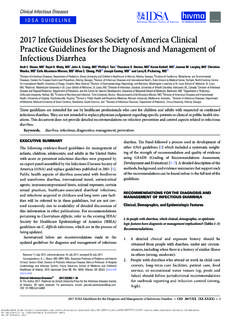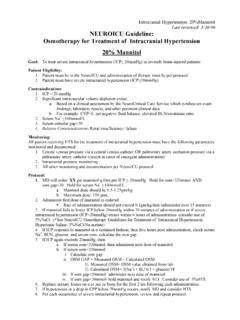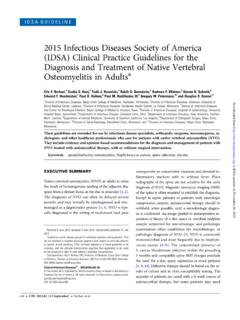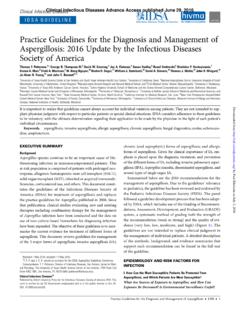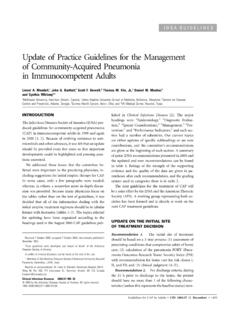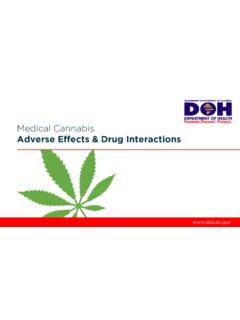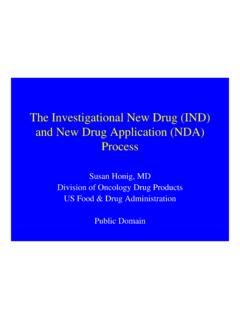Transcription of Guidelines for the Management of Adverse Drug Effects of ...
1 Guidelines for the Management of Adverse drug Effects ofAntimycobacterial AgentsLawrence Flick Memorial Tuberculosis ClinicPhiladelphia Tuberculosis Control ProgramNovember 19981 Table of ContentsSubjectPage(s)Drugs Used in the Treatment of Tuberculosis2 Section I: Most Common Adverse drug Effects Listed by Adverse Effect3-18 Dermatologic Adverse Effects4-6cutaneous flushing reactions4hypersensitivity reactions5-6 Gastrointestinal Adverse Effects7-13nausea/vomiting7-9diarrhea10- 11hepatotoxicity12-13 Miscellaneous Adverse Effects14-18arthalgias (joint pain)14-15influenza syndrome16neurotoxicity (nervous system)17optic neurit is (visio n)18 Section II: Adverse drug Effects and drug Interactions Listed by Drug19-48amikacin20-21capreomycin22-23cl ofazimine24-25cycloserine26-27ethambutol 28-29ethionamide30-31isoniazid32-34kanam ycin20-21levofloxacin40-41ofloxacin40-41 para-aminosalicylic acid36-37pyrazinamide38-39rifampin42-45r ifabutin46rifapentine47streptomycin20-21 TablesTable 1: drug Rechallenge ProtocolTable 2: Aminoglycoside Monitoring Parameters521 FiguresFigure 1: Management of Nausea & Vomiting9 Appendixes49-57 Appendix 1: Selected Antihistamines for the Prevention/Treatment of Cutaneous Flushing ReactionsAppendix 2: Oral Desensitization Protocol for IsoniazidAppendix 3: Oral Desensitization Protocol for Rifampinand EthambutolAppendix 4: Guidelines for Medication AdministrationAppendix 5.
2 Technique for Medication Administration toChildren with a SyringeAppendix 6: drug Use in Pregnancy495051525354-57 References58-592 drug Used in the Treatment of TuberculosisFirst Line DrugsGeneric NameTrade Nameisoniazid (INH)Laniazid , Nydrazid rifampinRifadin , Rimactane rifapentinePrift in pyrazinamide (PZA)various generic products availableethambutolMyambutol streptomycinstreptomycinINH/rifampin combinationRifamate INH/rifampin/PZA combinationRifater Second Line DrugsGeneric NameTrade NameamikacinAmikin capreomycinCapastat Sulfate clofazimineLamprene cycloserineSeromycin ethionamideTrecator-SC kanamycinkanamycinlevofloxacinLevaquin oflo xacinFlo xin para-aminosalicylic acidPaser rifabutinMycobutin 3 Section IMost Common Adverse drug Effects Listedby the Type of Adverse Effect4 Dermatologic (Skin) Adverse EffectsMild flushing reactions (two different types of reactions )
3 Clinical presentationsReaction 11 flushing and/or itching of the skin with or without a rash usually involves the face and scalp; may cause redness/watering of the eyes usually occurs 2-3 hours after drug ingestionReaction 22,3 flushing and/or itching of the skin with or without a rash PLUS hot flashes, palpitations,headache and/or increased blood pressure occurs immediately after ingestion of certain foods (see below) usually resolves within 2 hoursCausative agentsReaction 1: rifampin, pyrazinamide1 Reaction 2: isoniazid + tyramine containing foods (cheese, red wine) or certain fish (tuna,skipjack) 2,3 ManagementReaction 11 flushing is usually mild and resolves without therapy if flushing is bothersome to the patient, an antihistamine may be administered to treat orprevent the reaction (refer to Appendix 1, page 49)Reaction 2advise patient not to ingest foods listed above while receiving INHR efer also to individual drug monographs.
4 Isoniazid pages 32-34pyrazinamide pages 38-39rifampin pages 42-455 Dermatologic (Skin) Adverse EffectsModerate/severe hypersensitivity (immune) reactionsClinical Presentationhives (raised, itchy rash) with or without feverCausative Agents1 INH < rifampin < PZA < ethionamide < cycloserine < ethambutol <para-aminosalicylic acid < streptomycinNote: in children, viral infections ( Epstein-Barr and Herpes Simplex) commonly resultin hives that may be confused with a drug Discontinue all drugs2. Rule out a viral infect iona. full physical examb. complete blood count (examine for lymphocytosis)3. If a viral infection is present, restart all of the TB medications (no rechallenge is required)4. If a viral infection is ruled out, follow drug rechallenge Guidelines outlined in the adultmanagement Guidelines (below); doses must be adjusted for age and Discontinue all drugs until the reaction resolves2.
5 Identify the causative drug by rechallenging (restarting) each drug every 4 days according toTable 1 (example follows on next page).Table 11 drug Rechallenge ProtocolChallenge DosesDrugDay 1 Day acid (PAS) begin the rechallenge with INH 50mg on day 11) if the original reaction was severe, begin the rechallenge with 1/10 the day 1 doselisted in Table 1 ( INH 5mg)b. if a reaction does not occur after the day 1 dose, increase the INH to 300mg on day 2c. if a reaction does not occur after the day 2 dose, continue INH 300mg q dayd. continue to add drugs in the order and doses specified on Table 1 every 4 days1) if the original reaction was severe, begin the rechallenge with 1/10 the day 1 doselisted in Table 12) if the day 2 dose is less than the normal recommended dose based on the patient sweight, increase to the appropriate dose on day 3(a) example for ethambutol dosing in a 70kg person: day 1=100mg, day 2=500mg,and day 3=1000mg3.
6 If a reaction occurs during drug rechallenge and the causative drug can not be discontinued, drug desensitization will be necessary1,3 drug desensitization should not be attempted with severe skin reactions or thoseinvolving the mouth or mucous membranes ( exfoliative dermatitis and Stevens-Johnson Syndrome) consideration should be given to desensitizing patients under monitored conditions forsevere reactionsb. the patient should be receiving > 2 other TB medications before undergoing drugdesensit izat ion3c. three desensitization protocols have been utilized(i) general protocol1(a) initiate the day 1 dose as indicated in Table 1(b) if a reaction occurred after day 1 of drug rechallenge, begin desensitization with1/10 of the day 1 dose(c) double each dose and administer twice daily until the recommended daily dosehas been achieved(d) administer the recommended daily dose for 3 days, then switch to once dailydosing ( INH 150mg bid x 3 days, then 300mg q day)(e) if a reaction develops during desensitization, decrease the dose to the highest dose(the previous dose) that did not cause a reaction and begin increasing the doses insmaller increments(ii) rapid desensit ization for isoniazid4 (refer to Appendix 2, page 50)(iii)rapid desensitization for rifampin and ethambutol5 (refer to Appendix 3, page 51)d.
7 Steroids may be utilized if drug desensitization is urgent1:(i) severe TB(ii) severe drug reaction(iii) hypersensitivity to > 1 druge. patients should receive daily dosing after drug desensitization is completed (no twiceweekly or thrice weekly regimens)7 Gastrointestinal Adverse EffectsNausea/vomitingCausative AgentsRanked by frequency:++++++++++++++uncommoncommonve ry common+++++clofazimine, ethionamide, para-aminosalicylic acid (PAS)++++rifampin+++rifabutin, isoniazid (twice and thrice weekly dosing)++ethambutol, pyrazinamide, ofloxacin, levofloxacin+isoniazid (qD), rifapentine, cycloserine, aminoglycosides , capreomycin*ManagementChildren1. Examine how the medication is being administereda. Is the medication being administered as a liquid?1) administration of large volumes may cause vomiting because of the limited stomachcapacity in infants and children2) if this is the cause, the child usually vomits immediately after medicationadministration3) refer to Appendix 4, page 52b.
8 Is the child gagging when medicine is administered?1) children frequently gag to avoid taking medicine2) administration of medication through a syringe is the best method to avoid gagging 3) refer to Appendixes 4-5, pages 52-53c. Does the child take the medicine on an empty stomach?1) if so, give medications after meals ( ask school nurse to administer medicationsafter lunch)2. Rule out other causes of nausea and vomitinga. How often does nausea and vomiting occur?b. When does it start in relation to taking the medications?c. Could the child have a viral infection?3. If the TB medications are the likely cause of gagging, nausea or vomiting, follow the nauseaand vomiting Management algorithm on page 9. Although nausea and vomiting are uncommon Adverse Effects of the aminoglycosides (streptomycin, amikacin,kanamycin) and capreomycin, it may be an indication of vestibular toxicity (inner-ear toxicity).
9 If this occurs,contact a TB Control Rule out other causes of nausea and vomitinga. Ask questions: Have you had stomach problems in the past? If so, did it feel like this? What made your stomach problems better in the past? Did you eat/drink or do anything differently than usual the day you hadnausea/vomiting? How often do you have nausea and vomiting? When does it start in relation to taking your TB medications? How long does it last? Does it happen every time you take your medicine? Is it difficult for you to swallow your pills? How much water or juice do you drink when taking your pills? b. Consider measuring liver function tests to rule out drug induced hepatic dysfunction(refer to Hepatotoxicity section, pages 12-13).2. If the TB medications are the likely cause of the patient s nausea/vomiting, follow themanagement algorithm on the following also to individual drug monographs, pages 19-489[Insert Figure 1]10 Gastrointestinal Adverse EffectsDiarrheaClinical Presentation 3 loose bowel movements per dayCausative AgentsRanked by frequency:++++++++++++++uncommoncommonve ry common+++++clofazimine, ethionamide, para-aminosalicylic acid (PAS)+++rifampin++rifabutin, ofloxacin, levofloxacin+isoniazid, ethambutol, pyrazinamide, rifapentine, cycloserine,aminoglycosides, capreomycinManagement1.
10 Rule out other causes of diarrheaa. Children 1) Are liquid preparations being administered?a) diarrhea can be caused by the lactose and sucrose contained in liquid preparations b) usually, the first episode of diarrhea occurs when therapy is initiated c) crush medications (refer to Appendix 4, page 52) instead of using liquidpreparations2) Is the diarrhea caused by a viral infection?a) rotavirus season is between February to May and is a common cause of diarrheain childrenb) send viral stool culturesc) an example of diarrhea that is more likely caused by a virus than the medicationsis if the child develops diarrhea after previously tolerating the medicine for aprolonged time periodb. Adults 1) Ask questions Have you had problems with diarrhea in the past? Did you eat/drink anything unusual within 1-2 days of the onset of diarrhea?
